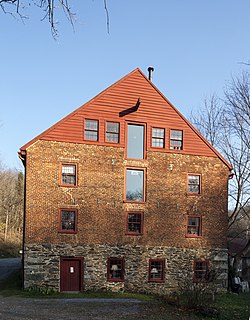
Cherry Grove, located on property formerly called Fredericksburg, 400 acres patented by Orlando Griffith's oldest son Henry Griffith in 1750. Cherry Grove is a historic home and former plantation located at Woodbine, Howard County, Maryland, United States. The home is considered the seat of the Warfield family of Maryland.

Roberts Inn, is a historic home and farm located at Cooksville, Howard County, Maryland. The complex consists of a 2+1⁄2-story stuccoed stone house with a reconstructed log wing built about 1808, and several 19th- to early-20th-century agricultural outbuildings, including a frame bank barn, a frame ground barn, a tile dairy, and a frame silo. The construction of the house coincided with the extension of the National Pike through the Cooksville area. Documentary and architectural evidence supports its use as a turnpike tavern from an early date. Tradition holds that Marquis de Lafayette breakfasted at Roberts Inn during his 1824 tour of America.

Rosehill is a historic home and property at Gambrills, Anne Arundel County, Maryland. The property consists of 17 acres (69,000 m2) of partially wooded and cleared land on which are located a dwelling and six outbuildings. The dwelling displays a complex construction evolution originating from a mid-18th-century frame, 1+1⁄2-story double-pile plan house with an unusual short side passage. This is believed to be the first documented example of this form in the Chesapeake Bay region. The six outbuildings include an early-19th-century frame corn house, a documented 1821 frame tobacco barn, a log outbuilding, a late-19th-century stable, and a late-19th- or early-20th-century pumphouse. The Hopkins family owned the property for 173 years, from 1799 until 1972.

The Inns on the National Road is a national historic district near Cumberland, Allegany County, Maryland. It originally consisted of 11 Maryland inns on the National Road and located in Allegany and Garrett counties. Those that remain stand as the physical remains of the almost-legendary hospitality offered on this well-traveled route to the west.

The Routzahn-Miller Farmstead is a historic home and farm complex located at Middletown, Frederick County, Maryland, United States. It consists of a Federal style-influenced brick house and smokehouse, both built about 1825; a later frame out-kitchen / washhouse; a standard Pennsylvania barn; a 20th-century dairy barn and milk house; and a 20th-century equipment shed. The Pennsylvania barn was probably built in the late 19th century and was recently rehabilitated for use as a preschool. The complex is located on a 16.7-acre (68,000 m2) parcel on the east flank of South Mountain. It is representative example of a type of domestic and agricultural grouping which characterized the rural mid-Maryland region from the early 19th century through World War II era.
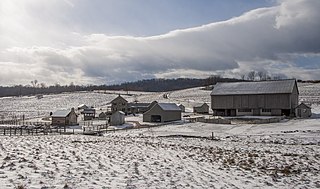
Peter of P. Grossnickel Farm is a historic home and farm complex located at Myersville, Maryland, Frederick County. It consists of a mid-19th-century, Greek Revival farmhouse and 13 related buildings and structures. The house is a 2+1⁄2-story stone center-passage house on a limestone foundation, with a 1+1⁄2-story kitchen wing and 18-inch-thick (460 mm) walls. The house was built between 1840 and 1850. Also on the property is an 1881 tenant house with corresponding barn, spring house, and washhouse / privy; an 1884–1897 bank barn; a pre-1830 granary; a 19th-century wood shed; late-19th-century hog pen / chicken house; a pre-1830 beehive oven; a late-19th-century smokehouse; a spring house with a Late Victorian cottage addition; and early-20th-century concrete block milk house; and a log summer kitchen of unknown date. The Grossnickel family was a German American family who were instrumental in the establishment of the Grossnickel Church of the Brethren.
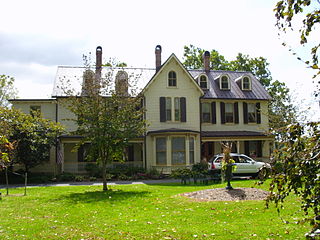
The Highland Lodge, also known as Pequea, is a historic home and resort building complex located at Frederick, Frederick County, Maryland, United States. It consists of a large Victorian period frame house centered at the end of a circular driveway, and its complement of outbuildings. The house is large and rambling and considered eclectic in style with a prominent central projecting gable. The property includes a frame stable and carriage house, now garages; a small frame barn; a small log dwelling moved to the property in the early 20th century; a frame summer kitchen and a frame secondary dwelling. It was developed originally in 1881 as a summer home for John H. Williams, a wealthy and influential Frederick attorney and banker.
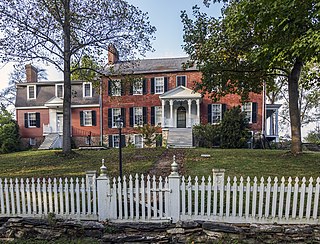
Hopewell is a set of historic homes and farm complexes located at Union Bridge, Carroll County, Maryland, United States. It consists of four related groupings of 19th century farm buildings. The Hopewell complex consists of two historic farms: Hopewell and the smaller F.R. Shriner Farm.
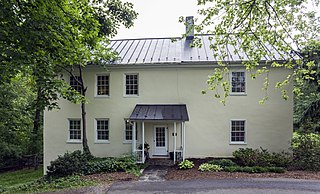
The Good–Hartle Farm is a historic home and farm complex located near Hagerstown, Washington County, Maryland, United States. The house is a two-part, two-story stuccoed structure, with a log section built in 1765, and 1833 limestone addition. A 1+1⁄2-story frame addition dates from the 20th century. Also on the property is an early-19th-century log springhouse with a cooking fireplace, and two late-19th- to early-20th-century frame outbuildings.
Kefauver Place is a historic farm complex located at Rohrersville, Washington County, Maryland, United States. It includes a log cabin built about 1820; a log barn of about 1830 with later-19th-century additions; a 19th-century timber-framed corn crib; a two-story brick house constructed around 1880; an early-20th-century masonry root cellar; and a frame summer kitchen, hog pen, chicken house, and garage all dating from about 1930. Also on the property are two fieldstone spring enclosures. It is located on a 21-acre (85,000 m2) property.
Snively Farm is a historic home and farm located near Eakles Mills, Washington County, Maryland, United States. It is a two-story, three-bay 18th century log structure with an exposed basement at the front elevation on fieldstone foundations. The home features a two-story, three-bay rear addition built in the late 18th or early 19th century with a one-story, two-bay stone kitchen. The property includes a stone springhouse and a frame butchering or outkitchen with a massive stone exterior chimney.
Nicodemus Mill Complex is a historic home and mill complex located at Keedysville, Washington County, Maryland, United States. It consists of a dated 1810 2+1⁄2-story, five-bay stone house with a mid-19th-century brick service wing, the ruins of a grist mill built about 1829, and an extensive complement of 19th-century domestic and agricultural outbuildings including a stone springhouse, stone-end bank barn, brick out kitchen, frame wash house, and a stuccoed stone secondary dwelling. It is an intact representative example of the type of farmstead characteristic of the region during the 19th century.

Plinlimmon Farm is a historic home and farm complex located at Owings Mills, Baltimore County, Maryland. It is an early 19th-century farmhouse of log construction clad in novelty siding. It is composed of six irregularly spaced bays, one room deep, and two and a half stories high with a gable roof. Also on the property is a stone building with a gable roof built about 1850, a frame two-bay garage, a small rectangular smokehouse built about 1850, a large mid-19th century cornhouse, and an early 20th-century frame barn.

Ivory Mills is a 14-acre (5.7 ha), historic grist mill complex located at White Hall, Harford County, Maryland, United States. It consists of six standing 19th century frame buildings and structures: mill, miller's house, barn, corncrib, carriage house, and chicken house. The property also includes the ruins of a stone spring house, and the stone abutments of a frame, Federal-era covered bridge. The focus of the complex is the three-story stone and frame mill building built about 1818. The ground story is constructed of coursed stone rubble and the upper stories are clapboard. The family first started a mill on this site in 1781, and this mill ceased functioning in the 1920s.

Gladden Farm, also known as Gladden-Roming Stone House, is a historic home and farm complex located in Street, Maryland. The complex includes three historically-significant structures: a large five-bay rubblestone bank house with Federal detailing, a one-story rubblestone spring house, and a one-story board-and-batten frame shop.

Philip and Uriah Arter Farm is a historic home and farm complex located at Union Mills, Carroll County, Maryland. The complex includes a frame house built about 1844, a frame bank barn built about 1888, and a deteriorated early-20th-century frame outbuilding. The house is a well-preserved example of a middling farmer's dwelling house from mid-19th-century Maryland.
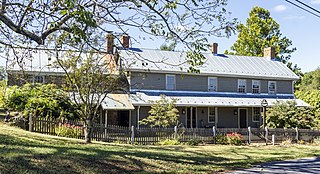
The McMurray–Frizzell–Aldridge Farm is a historic home and farm complex located at Westminster, Carroll County, Maryland, United States. It consists of a log house constructed about 1790 and later enlarged, and several 19th and early 20th century domestic and agricultural outbuildings, including a stone summer kitchen, a frame smokehouse, a frame bank barn, a frame wagon shed, a frame hog pen, and a stone spring house.
George Maddox Farm, also known as Cottage Hall Farm or Albert Sudler Farm, is a historic farm complex located at Manokin, Somerset County, Maryland. It is an intact complex of 15 agricultural buildings and structures dating from about 1800 through the early 20th century. The complex includes six pre-Civil War structures including a frame granary, two dairies, a log smokehouse, another (ruined) log outbuilding, and a frame kitchen/quarter. Seven post-war structures include a barn, two garages, tenant house, privy, well house, and chicken house. The main house is a 2+1⁄2-story irregular-plan Queen Anne house, roughly cruciform in plan. An early-19th-century single-story kitchen extends from the back of the house.

Whitaker's Mill Historic District is a national historic district near Joppa, Harford County, Maryland, United States. It includes three early- to mid-19th-century buildings: the 2+1⁄2-story rubble stone Whitaker's Mill built in 1851, the 1+1⁄2-story rubble stone miller's house, and the log-and-frame Magness House, begun about 1800 as the miller's house for the first mill on the site. The district also includes an iron truss bridge known as Harford County Bridge No. 51, constructed in 1878, and the oldest such span in the county. The grist mill closed operations about 1900.
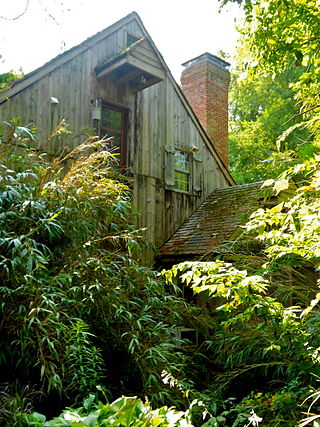
Jeremiah Brown House and Mill Site is a Colonial-era mill complex and national historic district at Rising Sun, Cecil County, Maryland, United States. It consists of two distinct halves: a two-story, three-bay, gable-roofed stone structure built in 1757 by Jeremiah Brown, Sr., a Quaker from Pennsylvania; and a two-story, two-bay gable-roofed frame house built in 1904 by John Clayton on the site of the original 1702 log wing. Also on the property is a small 19th century bank barn; a reconstruction of the original mill built on top of the stone foundations of the 1734 Brown Water Corn and Gristmill; and the foundations of an 18th-century saw mill.
